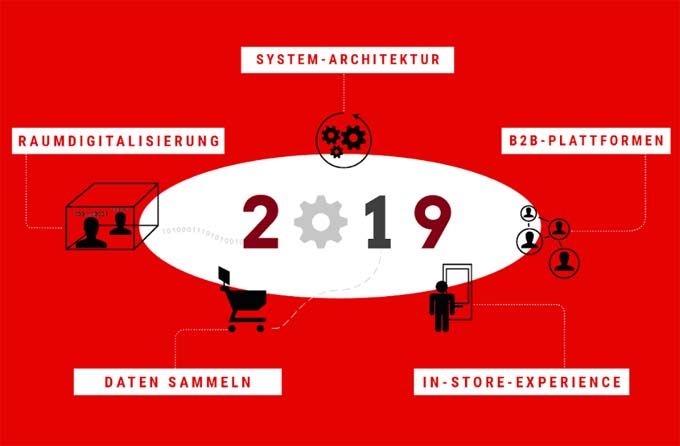Five digital trends for the retail industry
In just a few weeks, the new year will dawn. The ideal time to take a look at upcoming digital developments in retail. According to the digital agency Namics, five digital trends will be particularly important for the retail sector in 2019.

Between new store concepts that manage entirely without checkouts and the battle for supremacy in online retailing, the retail industry is also exposed to rapidly changing trends in other areas. Retail expert Alexander Henss, Senior Principal Consultant at Namics, reveals what these trends are.
1. data collection: the digitization of space
A great deal of data enters the retailer's showrooms along with the customers. So far, however, they have rarely been collected. As a result, brick-and-mortar retailers are missing out on enormous potential:
After all, the information generates revealing insights from which companies can derive appropriate measures or even new business models. Data can be used to clarify the following questions, for example:
- Which products immediately catch the customer's eye?
- Does the consumer touch certain objects to check the material?
- How do advertising measures work?
- What patterns of movement are created in the salesroom?
Amazon Go is a pioneer in the digitization of space. The American supermarket operates without checkouts, but customers have to register at the entrance using a smartphone code. Their movements and actions in the sales area are recorded by various sensors and evaluated by an algorithm.
2. offline, online, timeline: Network data optimally
Data also plays the main role in the second trend: the more facts are available about the customer, the more important it is to network them. With smart shopping carts, RFID and iBeacon technology, numerous values are collected offline in the retail industry. In order to be able to use these optimally, a functioning link with data from other channels, for example customer relationship management or search behavior on the website, is essential. A sophisticated strategy is needed so that the values can be combined to form a 360-degree customer picture. The following aspects must be taken into account:
- What data should be collected and what do they say?
- Which platform is used to collect or link the data?
- How does the evaluation take place?
- How can I use source data for predictive and prescriptive analytics?
Prescriptive analytics in particular are becoming increasingly important for retailers: they go one step further and enable the company to make additional recommendations for action. One example is the adjustment of parameters as part of a promotion to increase sales figures.
3. from shopping to experience: the in-store experience
Customers themselves are also moving more and more into digital worlds. Be it in online shopping or in social interaction. To ensure that the experience in the real store can keep up with that in the online store, retailers should rethink the design of their sales areas and incorporate digital solutions.
Smart screens can, for example, suggest matching accessories for pants or dresses in the dressing room. The use of virtual reality, on the other hand, makes it possible to better plan furniture or pictures into one's own home decor. Robots can, for example, bring suits in a different size and color to the customer's cubicle. And thanks to intelligent mirrors, new outfits can be shared with friends via social media channels.
4. disruption: B2B platforms on the rise
For the entire B2B segment, the entry of various global players such as Google, Amazon and Alibaba into the B2B business harbors both risks and opportunities. One thing is certain: in the long term, retailers will not be able to avoid platforms such as Amazon Business or Google Shopping. Anyone venturing into this still unknown territory must be prepared with a good strategy in any case. Is the platform in question even relevant for the customer journey? What technological requirements do I have to fulfill in order to become active in the digital marketplaces? Retailers urgently need answers to these questions in the coming year.
5. technology: system architecture in transition
In order to survive in the digital world, the right tools and methods are also indispensable in the retail sector. The technology behind them is becoming increasingly sophisticated and diverse. Thanks to modularization, the software architecture is also becoming more flexible. The replacement of systems used to date is up for debate. Today, and especially in the coming year, companies are confronted with the following questions:
- Software On Premises or Cloud-Based Services? However, this question is becoming increasingly rare, as many manufacturers now only offer their software as a cloud service and do not use on premise software.
- Can AI be used to present offers in a more relevant way or to optimize channels? For example, it can help to suggest the right products based on surfing behavior.
- How can data availability be increased across touchpoints? One touchpoint, for example, is the stationary checkout, which shows the retailer the entire purchase history of the respective customer.
- How can the DevOps approach be used to shape a continuous improvement process? For example, digital innovations can go live faster and be brought to the customer.
Regardless of the particular decision, retailers should always keep in mind that the change will not only create more convenience for their own business, but also for the customer.










